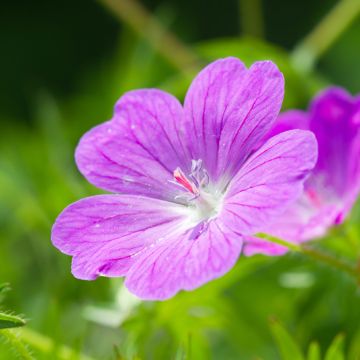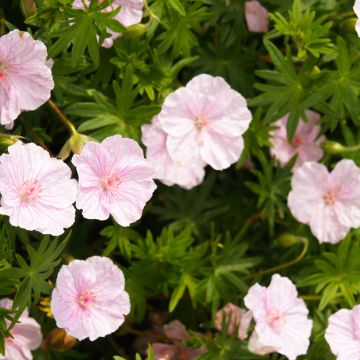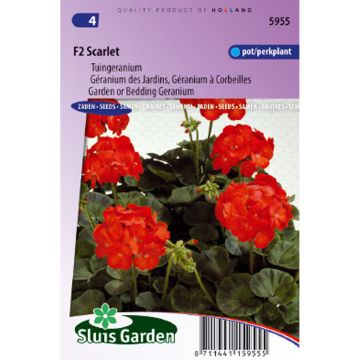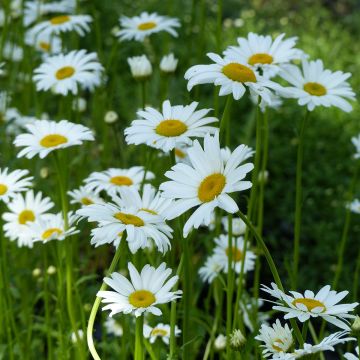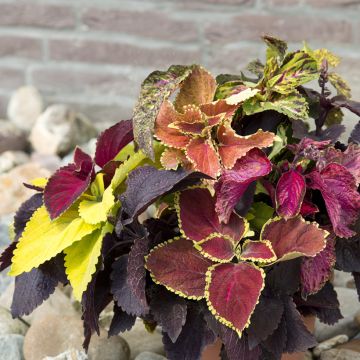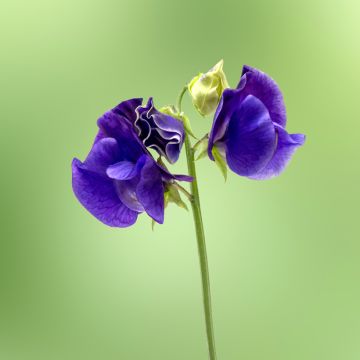

Géranium des Jardins F1 Raspberry Ripple - Pelargonium
Pelargonium Raspberry Ripple - F1 seeds
Pelargonium x hortorum F1 Raspberry Ripple
Zonal geranium, Garden geranium
This item cannot be shipped to the selected country
Dispatch by letter from €3.90
Delivery to Corse prohibited
More information
Schedule delivery date,
and select date in basket
This plant carries a 6 months recovery warranty
More information
We guarantee the quality of our plants for a full growing cycle, and will replace at our expense any plant that fails to recover under normal climatic and planting conditions.
Seed-only orders are dispatched by sealed envelope. The delivery charge for seed-only orders is €3.90.
Delivery to Corse prohibited: UE law prohibits the import of this plant from mainland France to Corse as part of the fight against Xylella fastidiosa. Please accept our sincere apologies.
More information
Does this plant fit my garden?
Set up your Plantfit profile →
Description
This Pelargonium or garden geranium, Raspberry Ripple is a perennial plant grown as an annual. It forms a small, compact bush with round, dark green, marbled foliage, which is covered for a very long period by very original salmon pink flowers, dotted with red. Ideal for pots and hanging baskets, this plant will fit well in sunny flower beds, in light, well-drained, and fertile soil. Sow indoors in warm conditions, and transplant into pots as soon as they sprout.
Hybrid zonal pelargoniums are plants from the geranium family, derived from various varieties including Pelargonium inquinans, native to the southeastern tip of Africa, Pelargonium zonale, and Pelargonium frutetorum. The Raspberry Ripple variety forms a small, compact bush, 35 cm (14in) high and 30 cm (12in) wide with succulent stems ranging from green to light brown and covered with circular to kidney-shaped, wavy green leaves, with distinct darker markings. From June to October, the refined and original, single flowers are massed along the stems and gathered in round, salmon-pink clusters, entirely splashed and dotted with red.
Once reserved for balconies and terraces, pelargoniums are becoming popular in sunny flower beds and borders. The advantage of growing from seed is that you can obtain many plants at a low cost, to be planted en masse and create a long-lasting and cheerful decoration throughout summer. These plants tolerate drought quite well, which allows them to be grown with garden verbenas, lobelias with incredible blues and black or purple-leaved morning glories (Ipomoea Illusion Midnight Lace, Ipomoea Sweet Heart Purple).
Report an error about the product description
Flowering
Foliage
Plant habit
Botanical data
Pelargonium
x hortorum
F1 Raspberry Ripple
Geraniaceae
Zonal geranium, Garden geranium
Cultivar or hybrid
Other Geranium seeds
Planting and care
Sow pelargonium seeds outdoors where they are to flower in April-May, after the last frost. Choose a sunny location on well-drained soil, well-prepared and properly dug. Sow the seeds thinly, at a depth of 3mm (0in), with a spacing of 30 cm (12in). Water regularly, especially during dry periods. Germination usually takes about twenty days. When the plants are large enough to handle, transplant them to 15 cm (6in) apart. Alternatively, sow them indoors from August to September to achieve early summer flowering the following year. Sow the seeds on the surface of good quality seed compost at a temperature of 18-20°C (64.4-68°F), and cover with a pinch of very fine compost or vermiculite. Keep in the light as it facilitates germination. When the seedlings are large enough to be handled, transplant them into pots and grow them on, protected from the cold until the young plants are large enough to be moved outdoors. You can keep these plants in a frost-free area, before planting them in the ground in the following spring, or in pots. Pelargoniums thrive in fertile, well-drained, well-loosened soil and in full sunlight.
Sowing period
Intended location
-
, onOrder confirmed
Reply from on Promesse de fleurs
Flower seeds
Haven't found what you were looking for?
Hardiness is the lowest winter temperature a plant can endure without suffering serious damage or even dying. However, hardiness is affected by location (a sheltered area, such as a patio), protection (winter cover) and soil type (hardiness is improved by well-drained soil).

Photo Sharing Terms & Conditions
In order to encourage gardeners to interact and share their experiences, Promesse de fleurs offers various media enabling content to be uploaded onto its Site - in particular via the ‘Photo sharing’ module.
The User agrees to refrain from:
- Posting any content that is illegal, prejudicial, insulting, racist, inciteful to hatred, revisionist, contrary to public decency, that infringes on privacy or on the privacy rights of third parties, in particular the publicity rights of persons and goods, intellectual property rights, or the right to privacy.
- Submitting content on behalf of a third party;
- Impersonate the identity of a third party and/or publish any personal information about a third party;
In general, the User undertakes to refrain from any unethical behaviour.
All Content (in particular text, comments, files, images, photos, videos, creative works, etc.), which may be subject to property or intellectual property rights, image or other private rights, shall remain the property of the User, subject to the limited rights granted by the terms of the licence granted by Promesse de fleurs as stated below. Users are at liberty to publish or not to publish such Content on the Site, notably via the ‘Photo Sharing’ facility, and accept that this Content shall be made public and freely accessible, notably on the Internet.
Users further acknowledge, undertake to have ,and guarantee that they hold all necessary rights and permissions to publish such material on the Site, in particular with regard to the legislation in force pertaining to any privacy, property, intellectual property, image, or contractual rights, or rights of any other nature. By publishing such Content on the Site, Users acknowledge accepting full liability as publishers of the Content within the meaning of the law, and grant Promesse de fleurs, free of charge, an inclusive, worldwide licence for the said Content for the entire duration of its publication, including all reproduction, representation, up/downloading, displaying, performing, transmission, and storage rights.
Users also grant permission for their name to be linked to the Content and accept that this link may not always be made available.
By engaging in posting material, Users consent to their Content becoming automatically accessible on the Internet, in particular on other sites and/or blogs and/or web pages of the Promesse de fleurs site, including in particular social pages and the Promesse de fleurs catalogue.
Users may secure the removal of entrusted content free of charge by issuing a simple request via our contact form.
The flowering period indicated on our website applies to countries and regions located in USDA zone 8 (France, the United Kingdom, Ireland, the Netherlands, etc.)
It will vary according to where you live:
- In zones 9 to 10 (Italy, Spain, Greece, etc.), flowering will occur about 2 to 4 weeks earlier.
- In zones 6 to 7 (Germany, Poland, Slovenia, and lower mountainous regions), flowering will be delayed by 2 to 3 weeks.
- In zone 5 (Central Europe, Scandinavia), blooming will be delayed by 3 to 5 weeks.
In temperate climates, pruning of spring-flowering shrubs (forsythia, spireas, etc.) should be done just after flowering.
Pruning of summer-flowering shrubs (Indian Lilac, Perovskia, etc.) can be done in winter or spring.
In cold regions as well as with frost-sensitive plants, avoid pruning too early when severe frosts may still occur.
The planting period indicated on our website applies to countries and regions located in USDA zone 8 (France, United Kingdom, Ireland, Netherlands).
It will vary according to where you live:
- In Mediterranean zones (Marseille, Madrid, Milan, etc.), autumn and winter are the best planting periods.
- In continental zones (Strasbourg, Munich, Vienna, etc.), delay planting by 2 to 3 weeks in spring and bring it forward by 2 to 4 weeks in autumn.
- In mountainous regions (the Alps, Pyrenees, Carpathians, etc.), it is best to plant in late spring (May-June) or late summer (August-September).
The harvesting period indicated on our website applies to countries and regions in USDA zone 8 (France, England, Ireland, the Netherlands).
In colder areas (Scandinavia, Poland, Austria...) fruit and vegetable harvests are likely to be delayed by 3-4 weeks.
In warmer areas (Italy, Spain, Greece, etc.), harvesting will probably take place earlier, depending on weather conditions.
The sowing periods indicated on our website apply to countries and regions within USDA Zone 8 (France, UK, Ireland, Netherlands).
In colder areas (Scandinavia, Poland, Austria...), delay any outdoor sowing by 3-4 weeks, or sow under glass.
In warmer climes (Italy, Spain, Greece, etc.), bring outdoor sowing forward by a few weeks.



































